 |
Matronics Email Lists
Web Forum Interface to the Matronics Email Lists
|
| View previous topic :: View next topic |
| Author |
Message |
checkn6
Joined: 20 Feb 2010
Posts: 14
|
 Posted: Thu Aug 05, 2010 6:22 am Post subject: Icom A6 Power Supply Posted: Thu Aug 05, 2010 6:22 am Post subject: Icom A6 Power Supply |
 |
|
Hi Everyone,
Pardon my ignorance here but if it were not for this list and the AEC website and manual my electrical system would probably be in shambles. But on to my question.
I fly a Challenger and use an Icom A6 handheld for my radio until I can afford a panel mount. The instructions state that I must use the CP-20 cord (at) $55 to power it from the ships power. Seems a bit excessive to me but is there some kind of magic in the box that I'm just not getting? The radio takes an 11V input and I am guessing that the CP-20 has a charging system inside to recharge the NiMh battery. My real question is can I run the radio on a 12V cord without all the bells and whistles? I'm not trying to charge the battery in flight as I have a spare alkaline battery pack mounted to the panel that I can clip the radio body to while flying and un-clip when I get out. I remember years ago someone telling me that a radio of this quality can work on a somewhat wide range of external power as they have built in conversion, but like I said pardon my ignorance.
Thanks
Chris
| | - The Matronics AeroElectric-List Email Forum - | | | Use the List Feature Navigator to browse the many List utilities available such as the Email Subscriptions page, Archive Search & Download, 7-Day Browse, Chat, FAQ, Photoshare, and much more:
http://www.matronics.com/Navigator?AeroElectric-List |
|
|
|
| Back to top |
|
 |
rickofudall
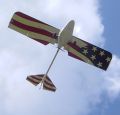
Joined: 19 Sep 2009
Posts: 1392
Location: Udall, KS, USA
|
 Posted: Thu Aug 05, 2010 8:22 am Post subject: Icom A6 Power Supply Posted: Thu Aug 05, 2010 8:22 am Post subject: Icom A6 Power Supply |
 |
|
Chris, Look in your owners manual, I was surprised to find that my A22 which had a simple cigarette style plug would work fine on 12 volts but the manual had a prohibition from plugging it into a 24 volt system or it would let the smoke out. I bought my A22 in 1999 so perhaps Icom has come to their senses with the A6.
I put the A22 in my trike and I power it from the 12 volt system. It works fine. I went to the DAV with the radio and went through their box of power supplies to find one that had a nice long cord and a plug that fits the radio's power receptical. I didn't care about voltage or polarity, just wanted the right plug. Bought the transformer for 25 cents, took it home and cut off the transformer and canned it. used an ohm meter to determine which wire went where, the center is + on the A22 and wired it into an extra fuse slot on the trike. Works great, no escaped smoke in two years.
Icom builds good handhelds, but their accessory prices are laughable to the point of arrogance. For my LSA I bought the cheapest Vertex handheld. It comes with a headset adapter all that's needed is a PTT switch, which Bob told me how to build then I found a ready made on at Mypilot for $11. I made my own antenna and the whole package barely broke $200 for everything. It's wired into the ship the same way as the trike (another 25 cent plug from DAV, too) and it too works great with no smoke. The Vertex even had Li battery pack instead of the Nicads and Nmh that Icom uses.
I don't own any stock in Vertex's parent company, I just like their radios and especially their prices.
Rick Girard
On Thu, Aug 5, 2010 at 9:22 AM, checkn6 <checkn6(at)yahoo.com (checkn6(at)yahoo.com)> wrote:
[quote]--> AeroElectric-List message posted by: "checkn6" <checkn6(at)yahoo.com (checkn6(at)yahoo.com)>
Hi Everyone,
Pardon my ignorance here but if it were not for this list and the AEC website and manual my electrical system would probably be in shambles. But on to my question.
I fly a Challenger and use an Icom A6 handheld for my radio until I can afford a panel mount. The instructions state that I must use the CP-20 cord (at) $55 to power it from the ships power. Seems a bit excessive to me but is there some kind of magic in the box that I'm just not getting? The radio takes an 11V input and I am guessing that the CP-20 has a charging system inside to recharge the NiMh battery. My real question is can I run the radio on a 12V cord without all the bells and whistles? I'm not trying to charge the battery in flight as I have a spare alkaline battery pack mounted to the panel that I can clip the radio body to while flying and un-clip when I get out. I remember years ago someone telling me that a radio of this quality can work on a somewhat wide range of external power as they have built in conversion, but like I said pardon my ignorance.
Thanks
Chris
Read this topic online here:
http://forums.matronics.com/viewtopic.php?p=307631#307631
===========
-List" target="_blank">http://www.matronics.com/Navigator?AeroElectric-List
===========
http://forums.matronics.com
===========
le, List Admin.
="_blank">http://www.matronics.com/contribution
===========
[b]
| | - The Matronics AeroElectric-List Email Forum - | | | Use the List Feature Navigator to browse the many List utilities available such as the Email Subscriptions page, Archive Search & Download, 7-Day Browse, Chat, FAQ, Photoshare, and much more:
http://www.matronics.com/Navigator?AeroElectric-List |
|
_________________
The smallest miracle right in front of you is enough to make you happy.... |
|
| Back to top |
|
 |
nuckolls.bob(at)aeroelect
Guest
|
 Posted: Thu Aug 05, 2010 9:15 am Post subject: Icom A6 Power Supply Posted: Thu Aug 05, 2010 9:15 am Post subject: Icom A6 Power Supply |
 |
|
At 09:22 AM 8/5/2010, you wrote:
| Quote: |
Hi Everyone,
Pardon my ignorance here but if it were not for this list and the
AEC website and manual my electrical system would probably be in
shambles. But on to my question.
I fly a Challenger and use an Icom A6 handheld for my radio until I
can afford a panel mount. The instructions state that I must use the
CP-20 cord (at) $55 to power it from the ships power. Seems a bit
excessive to me but is there some kind of magic in the box that I'm
just not getting? The radio takes an 11V input and I am guessing
that the CP-20 has a charging system inside to recharge the NiMh
battery. My real question is can I run the radio on a 12V cord
without all the bells and whistles? I'm not trying to charge the
battery in flight as I have a spare alkaline battery pack mounted to
the panel that I can clip the radio body to while flying and un-clip
when I get out. I remember years ago someone telling me that a radio
of this quality can work on a somewhat wide range of external power
as they have built in conversion, but like I said pardon my ignorance.
|
Good question. But with an answer similar to the
recent exchange about charging batteries in cordless
drills. Without analyzing a CP-20 to deduce its
mojo, there's little that anyone can offer you
with confidence. If we had a schematic of what
goes on inside it, I could certainly offer
solid advice. Suggest you get the recommended
cable. The $time$ expended to do a work-around
may well be more costly than using the stock
cable.
Bob . . .
| | - The Matronics AeroElectric-List Email Forum - | | | Use the List Feature Navigator to browse the many List utilities available such as the Email Subscriptions page, Archive Search & Download, 7-Day Browse, Chat, FAQ, Photoshare, and much more:
http://www.matronics.com/Navigator?AeroElectric-List |
|
|
|
| Back to top |
|
 |
icrashrc

Joined: 16 Mar 2006
Posts: 247
Location: Mishawaka, In
|
 Posted: Fri Aug 06, 2010 1:38 am Post subject: Re: Icom A6 Power Supply Posted: Fri Aug 06, 2010 1:38 am Post subject: Re: Icom A6 Power Supply |
 |
|
I have a A24 which i believe calls for the same $$power supply$$ as the A6. Mine needs to see between 9.5 and 11.7 volts at the plug to charge the battery AND to transmit. The A24 will still turn on, change channels, listen to traffic, charge the battery, etc above 11.7 volts but it will not transmit.
| | - The Matronics AeroElectric-List Email Forum - | | | Use the List Feature Navigator to browse the many List utilities available such as the Email Subscriptions page, Archive Search & Download, 7-Day Browse, Chat, FAQ, Photoshare, and much more:
http://www.matronics.com/Navigator?AeroElectric-List |
|
_________________
Scott
www.ill-EagleAviation.com
do not archive |
|
| Back to top |
|
 |
nuckolls.bob(at)aeroelect
Guest
|
 Posted: Fri Aug 06, 2010 5:28 am Post subject: Icom A6 Power Supply Posted: Fri Aug 06, 2010 5:28 am Post subject: Icom A6 Power Supply |
 |
|
At 04:38 AM 8/6/2010, you wrote:
| Quote: |
I have a A24 which i believe calls for the same $$power supply$$ as
the A6. Mine needs to see between 9.5 and 11.7 volts at the plug to
charge the battery AND to transmit. The A24 will still turn on,
change channels, listen to traffic, charge the battery, etc above
11.7 volts but it will not transmit.
|
Interesting data point! Thank you. This makes sense
as these tiny transceivers all have one thing in
common . . .
To get Power Output they need to have Power Input.
The best possible efficiency for the power output
stage of an AM transmitters has a practical limit
. . . where INEFFICIENCY manifests itself as heat.
When you've stuffed a multi-watt transmitter into
a envelope the size of a package of cigarets, the
designers best hopes for moving heat out of the
vulnerable circuits are severely restricted.
This bit of information suggests that external
power adapters for these radios may well contain
regulators designed to keep the radio from going
into self-protective shutdown when powered from
a DC bus supported at over 14v by an alternator.
Bob . . .
| | - The Matronics AeroElectric-List Email Forum - | | | Use the List Feature Navigator to browse the many List utilities available such as the Email Subscriptions page, Archive Search & Download, 7-Day Browse, Chat, FAQ, Photoshare, and much more:
http://www.matronics.com/Navigator?AeroElectric-List |
|
|
|
| Back to top |
|
 |
dougshep
Joined: 22 Jul 2010
Posts: 7
Location: Santa Barbara, CA
|
 Posted: Fri Aug 06, 2010 9:23 am Post subject: Icom A6 Power Supply Posted: Fri Aug 06, 2010 9:23 am Post subject: Icom A6 Power Supply |
 |
|
I'm trying to adapt my ICOM A23 (NAV/COM) hand held xcvr to my panel also. The A23 is very similar to your A6 electrically. I ordered a BP-200, battery eliminator (it replaces its battery) and connected it to my A6 and here is the letter I sent with the BP-200 back to W&W Manufacturing where I purchased it:
"I received your WWE-BP200 Battery eliminator for my ICOM A23 handheld transceiver. When using it by plugging it into an auto (engine was off) cigarette lighter, the transceiver seemed to work except produced so much static and noise (squeals) that it was not usable. Note that when using the transceiver in the same auto with its normal battery pack it worked perfectly. The transceiver uses its normal whip antenna that came with it. The auto battery measured 12.7 VDC, and also the same problem occurred in another auto I tested it in. I checked the BP200 with a volt meter and it produces the correct 10.0 VDC output. Apparently its power supply is producing the noise and its coupling into the transceiver. Perhaps its power supply is defective.Pse send me another BP200 without this noise problem."
Well, all I got was a refund to my credit card. The Battery eliminator uses a buck converter that produces a 200Khz power with enough noise to radiate into your antenna. Using 50feet of RG-58 and an external antenna routed the same distance, it worked pretty good. So, forget it unless you can shield its power supply or use an outside antenna.
I've just ordered ICOM's A23 service manual, and plan to panel mount my A23 with its battery pack using a charger/booster. The A23 can trickle or boost charge. I've heard good things about airborne ICOM handhelds (mine works good in flight), and panel mount NAV/COMs are $$$. I'd be careful about connecting your A6 directly to aircraft power. [quote][b]
| | - The Matronics AeroElectric-List Email Forum - | | | Use the List Feature Navigator to browse the many List utilities available such as the Email Subscriptions page, Archive Search & Download, 7-Day Browse, Chat, FAQ, Photoshare, and much more:
http://www.matronics.com/Navigator?AeroElectric-List |
|
_________________
Doug Shepard, RV-9A |
|
| Back to top |
|
 |
rose9065f
Joined: 30 Jan 2008
Posts: 10
Location: Pahrump, NV
|
 Posted: Sat Aug 07, 2010 5:57 am Post subject: Re: Icom A6 Power Supply Posted: Sat Aug 07, 2010 5:57 am Post subject: Re: Icom A6 Power Supply |
 |
|
I made a cable with a 10 ohm resistor in series with the 12 volt feed from the plane to the A24. This puts a small charge into the A24 battery, but the radio still operates from its internal battery. Works fine. !0 ohms is not too critical. The wall charger says 200ma. Dropping 13 volts to 11.7 at 200ma is about 6.5 ohms Bigger resistor smaller trickle charge.
Jim
| | - The Matronics AeroElectric-List Email Forum - | | | Use the List Feature Navigator to browse the many List utilities available such as the Email Subscriptions page, Archive Search & Download, 7-Day Browse, Chat, FAQ, Photoshare, and much more:
http://www.matronics.com/Navigator?AeroElectric-List |
|
_________________
KF2 582 |
|
| Back to top |
|
 |
rvtach
Joined: 28 Jan 2008
Posts: 26
Location: Tucson, AZ
|
 Posted: Sat Aug 07, 2010 8:01 am Post subject: Re: Icom A6 Power Supply Posted: Sat Aug 07, 2010 8:01 am Post subject: Re: Icom A6 Power Supply |
 |
|
| rose9065f wrote: | I made a cable with a 10 ohm resistor in series with the 12 volt feed from the plane to the A24. This puts a small charge into the A24 battery, but the radio still operates from its internal battery. Works fine. !0 ohms is not too critical. The wall charger says 200ma. Dropping 13 volts to 11.7 at 200ma is about 6.5 ohms Bigger resistor smaller trickle charge.
Jim |
I had forgotten I had any experience with this. When I was in charge of aircraft parking for COPPERSTATE Fly-In we used a bunch of A-6s, which as mentioned earlier won't transmit when it's on the charger. Who's idea was that anyway? With heavy use the batteries died in under 2 hours and then we were going through a set of AAs every 30 minutes. Our radio guy did something similar to what Jim here did by soldering a bunch of diodes in series inside the AA adapter battery pack to get the right voltage and then bringing a cable/cigarette lighter plug out to run off my golf cart battery. I don't remember exactly what diodes he used or how many but it worked like a charm.
If you're is interested I can find out exactly how he did this. Just have to get out to the airport and open up his creation and see exactly what's in there. I'll take a photo or 2 while I'm at it. I see that the AA pack is only about 15 dollars at Chief and the half dozen or so diodes would only cost a couple dollars.
Jim in Tucson
| | - The Matronics AeroElectric-List Email Forum - | | | Use the List Feature Navigator to browse the many List utilities available such as the Email Subscriptions page, Archive Search & Download, 7-Day Browse, Chat, FAQ, Photoshare, and much more:
http://www.matronics.com/Navigator?AeroElectric-List |
|
|
|
| Back to top |
|
 |
nuckolls.bob(at)aeroelect
Guest
|
 Posted: Sat Aug 07, 2010 9:42 am Post subject: Icom A6 Power Supply Posted: Sat Aug 07, 2010 9:42 am Post subject: Icom A6 Power Supply |
 |
|
| Quote: | | The A23 can trickle or boost charge. I've heard good things about airborne ICOM handhelds (mine works good in flight), and panel mount NAV/COMs are $$$. |
I've always had very good luck with Icom radio
performance (20+ years ago) but I've not acquired
any experience with newer products. If one assumes
they've maintained or refined their legacy design
and business models in a good way, the level
of customer satisfaction for performance should
still be very high.
| Quote: | | I'd be careful about connecting your A6 directly to aircraft power. |
Agreed. But your comments about the power adapter
putting out 10v raised some new flags. What we're
needing here is an operating support power source
to augment batteries . . . not a battery charger.
The 10V value along with other comments about
an 11.7 volt transmitter shutdown suggest a
solution that keeps external power constrained
to 10-11 volts but without regard to charging
batteries which is a more demanding protocol.
Just adding a resistor in series with the power
lead is problematic . . . because the current
demands of the radio are all over the place.
Receiver quiet (squelched) is the lowest drain.
Receiver working and putting out audio power
is somewhat higher. Transmitter working is
MUCH higher.
So I think it's a pretty safe bet to design a
noise free (linear) step-down regulator set
for say 10.5 volts using an LM317 regulator
from radio shack.
The data sheet for the LM317 . . .
http://cache.national.com/ds/LM/LM117.pdf
. . . says that with
a 200 mA load at 50C case temperature on the
device, the dropout voltage (differential
between input and output where it looses
regulation) is on the order of 1.6 volts.
[img]cid:.0[/img]
This means that a 10.5V regulator crafted
with this part would maintain regulation
performance with an input supply as low
as 10.5 + 1.6 = 12.1 volts which certainly
covers all operations with the alternator
working . . . and if the alternator is not
working, one can reasonably expect the
radio to work fine on internal batteries
for the time it takes to comfortably put
wheels on the ground.
I'm 99% sure that crafting the circuit
below will produce a power source that
will operate the radio. It may not charge
the battery . . . so use the radios normal
charger(s) to top of batteries before flight.
[img]cid:.1[/img]
Bob . . .
| | - The Matronics AeroElectric-List Email Forum - | | | Use the List Feature Navigator to browse the many List utilities available such as the Email Subscriptions page, Archive Search & Download, 7-Day Browse, Chat, FAQ, Photoshare, and much more:
http://www.matronics.com/Navigator?AeroElectric-List |
|
| Description: |
|
| Filesize: |
58.54 KB |
| Viewed: |
18023 Time(s) |
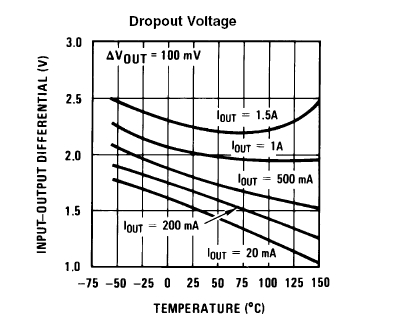
|
| Description: |
|
| Filesize: |
41.99 KB |
| Viewed: |
18023 Time(s) |
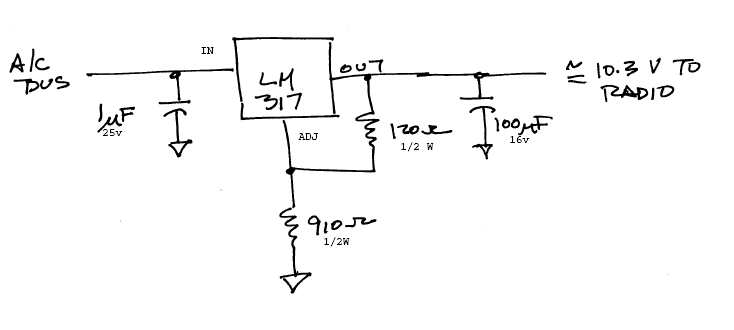
|
|
|
| Back to top |
|
 |
JOE RONCO
Joined: 04 Aug 2007
Posts: 31
Location: CENTENNIAL COLORADO
|
 Posted: Sat Aug 07, 2010 11:20 am Post subject: Icom A6 Power Supply Posted: Sat Aug 07, 2010 11:20 am Post subject: Icom A6 Power Supply |
 |
|
The Batteries America CP-11L might be a good way to go for use with 12 Volt plane power. See:
http://www.mypilotstore.com/mypilotstore/sep/3490
User reviews at bottom of page give it 4 or 5 stars.
Joe R
From: owner-aeroelectric-list-server(at)matronics.com [mailto:owner-aeroelectric-list-server(at)matronics.com] On Behalf Of Robert L. Nuckolls, III
Sent: Saturday, August 07, 2010 11:41 AM
To: aeroelectric-list(at)matronics.com
Subject: Re: Icom A6 Power Supply
| Quote: |
The A23 can trickle or boost charge. I've heard good things about airborne ICOM handhelds (mine works good in flight), and panel mount NAV/COMs are $$$. |
I've always had very good luck with Icom radio
performance (20+ years ago) but I've not acquired
any experience with newer products. If one assumes
they've maintained or refined their legacy design
and business models in a good way, the level
of customer satisfaction for performance should
still be very high.
I'd be careful about connecting your A6 directly to aircraft power.
Agreed. But your comments about the power adapter
putting out 10v raised some new flags. What we're
needing here is an operating support power source
to augment batteries . . . not a battery charger.
The 10V value along with other comments about
an 11.7 volt transmitter shutdown suggest a
solution that keeps external power constrained
to 10-11 volts but without regard to charging
batteries which is a more demanding protocol.
Just adding a resistor in series with the power
lead is problematic . . . because the current
demands of the radio are all over the place.
Receiver quiet (squelched) is the lowest drain.
Receiver working and putting out audio power
is somewhat higher. Transmitter working is
MUCH higher.
So I think it's a pretty safe bet to design a
noise free (linear) step-down regulator set
for say 10.5 volts using an LM317 regulator
from radio shack.
The data sheet for the LM317 . . .
http://cache.national.com/ds/LM/LM117.pdf
. . . says that with
a 200 mA load at 50C case temperature on the
device, the dropout voltage (differential
between input and output where it looses
regulation) is on the order of 1.6 volts.
[img]cid:image001.jpg(at)01CB3632.59B267C0[/img]
This means that a 10.5V regulator crafted
with this part would maintain regulation
performance with an input supply as low
as 10.5 + 1.6 = 12.1 volts which certainly
covers all operations with the alternator
working . . . and if the alternator is not
working, one can reasonably expect the
radio to work fine on internal batteries
for the time it takes to comfortably put
wheels on the ground.
I'm 99% sure that crafting the circuit
below will produce a power source that
will operate the radio. It may not charge
the battery . . . so use the radios normal
charger(s) to top of batteries before flight.
[img]cid:image002.jpg(at)01CB3632.59B267C0[/img]
Bob . . .
| | - The Matronics AeroElectric-List Email Forum - | | | Use the List Feature Navigator to browse the many List utilities available such as the Email Subscriptions page, Archive Search & Download, 7-Day Browse, Chat, FAQ, Photoshare, and much more:
http://www.matronics.com/Navigator?AeroElectric-List |
|
| Description: |
|
| Filesize: |
58.54 KB |
| Viewed: |
18022 Time(s) |
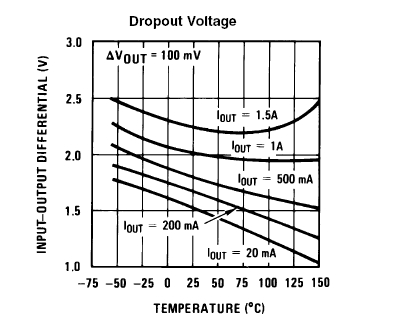
|
| Description: |
|
| Filesize: |
41.99 KB |
| Viewed: |
18022 Time(s) |
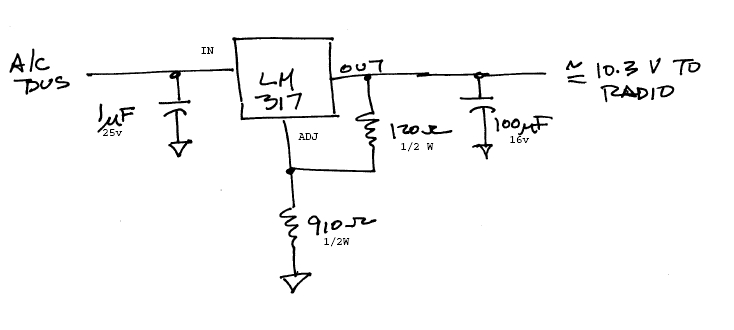
|
|
|
| Back to top |
|
 |
rose9065f
Joined: 30 Jan 2008
Posts: 10
Location: Pahrump, NV
|
 Posted: Sun Aug 08, 2010 6:20 am Post subject: Re: Icom A6 Power Supply Posted: Sun Aug 08, 2010 6:20 am Post subject: Re: Icom A6 Power Supply |
 |
|
" because the current
demands of the radio are all over the place."
Doesn't matter, the radio is running off its internal battery. The series resistor is trickle charging.
Simpler is better.
Jim
| | - The Matronics AeroElectric-List Email Forum - | | | Use the List Feature Navigator to browse the many List utilities available such as the Email Subscriptions page, Archive Search & Download, 7-Day Browse, Chat, FAQ, Photoshare, and much more:
http://www.matronics.com/Navigator?AeroElectric-List |
|
_________________
KF2 582 |
|
| Back to top |
|
 |
skywagon
Joined: 11 Feb 2006
Posts: 184
|
 Posted: Sun Aug 08, 2010 9:39 am Post subject: Icom A6 Power Supply Posted: Sun Aug 08, 2010 9:39 am Post subject: Icom A6 Power Supply |
 |
|
Jim,
There maybe a small flaw in your "10 ohm" conclusion.
As the A24 battery charges using your method and the voltage rises in the
battery, the current will taper off. So far, so good. However, it will go
into a mode of such low current that the 10 ohm resister becomes nearly
invisible. This then, will allow the A24 battery set to eventually rise to
the full level of the voltage source....13+ volts.
Maybe this is Ok, most cases it is not. If the radio is used for just a
short time during flying and then, disconnected from the 12+ source, most
likely this will stop any overcharging effect. If left connected to the
source voltage, then the A24 battery will eventually reach that value also,
which could be damaging.....
..2 cents... worth.
David
_________________________________________________________
---
| | - The Matronics AeroElectric-List Email Forum - | | | Use the List Feature Navigator to browse the many List utilities available such as the Email Subscriptions page, Archive Search & Download, 7-Day Browse, Chat, FAQ, Photoshare, and much more:
http://www.matronics.com/Navigator?AeroElectric-List |
|
|
|
| Back to top |
|
 |
nuckolls.bob(at)aeroelect
Guest
|
 Posted: Sun Aug 08, 2010 4:44 pm Post subject: Icom A6 Power Supply Posted: Sun Aug 08, 2010 4:44 pm Post subject: Icom A6 Power Supply |
 |
|
At 12:37 PM 8/8/2010, you wrote:
| Quote: |
Jim,
There maybe a small flaw in your "10 ohm" conclusion.
As the A24 battery charges using your method and the voltage rises
in the battery, the current will taper off. So far, so
good. However, it will go into a mode of such low current that the
10 ohm resister becomes nearly invisible. This then, will allow the
A24 battery set to eventually rise to the full level of the voltage
source....13+ volts.
Maybe this is Ok, most cases it is not. If the radio is used for
just a short time during flying and then, disconnected from the 12+
source, most likely this will stop any overcharging effect. If left
connected to the source voltage, then the A24 battery will
eventually reach that value also, which could be damaging.....
...2 cents... worth.
David
|
Excellent observation Dave. An alternative solution
was proposed wherein a series of diodes were
placed in series with the supply line. Each
diode contributes its own forward conduction
drop on the order of .6 volts per diode. This
approach simply tosses off a relatively fixed
amount of voltage.
The problem with both of these configurations
is that the output voltage to the radio is
not very stable for all conditions. This
is why most designers will include some sort
of active regulation in their external power
adapters.
The switchmode device that started this
thread is the most efficient and can be quite
small for it's capabilities. But these
necessarily include POWER oscillators which
can and do behave like little transmitters.
The minimum-risk approach for the electronic
handy-man is some form of linear regulator . . .
which demands consideration for "head-room"
or "drop-out" voltage. This is a characteristic
of all step-down regulators that defines
how well it performs as the input voltage
falls toward the same value as the output
voltage.
The diagram I posted yesterday promises
good output regulation with an input as
low as 1.6 volts above output. There
are specialty regulators that offer lower
dropout voltage but as long as we're not
attempting to charge batteries or get
rated performance with a dead alternator,
then the diagram posted offers good value.
Bob . . .
| | - The Matronics AeroElectric-List Email Forum - | | | Use the List Feature Navigator to browse the many List utilities available such as the Email Subscriptions page, Archive Search & Download, 7-Day Browse, Chat, FAQ, Photoshare, and much more:
http://www.matronics.com/Navigator?AeroElectric-List |
|
|
|
| Back to top |
|
 |
|
|
You cannot post new topics in this forum
You cannot reply to topics in this forum
You cannot edit your posts in this forum
You cannot delete your posts in this forum
You cannot vote in polls in this forum
You cannot attach files in this forum
You can download files in this forum
|
Powered by phpBB © 2001, 2005 phpBB Group
|






